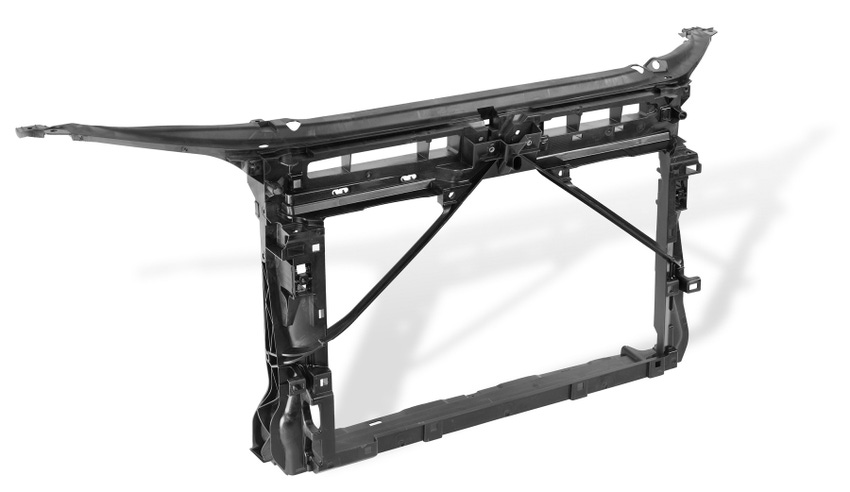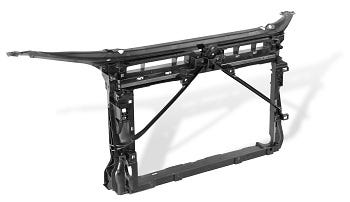Passenger car front end carriers can now be designed exclusively of plastic, as illustrated by the new Skoda Octavia. The vehicle's front end carrier is made of Durethan DP BKV 60 H2.0 EF, a highly reinforced polyamide (PA) 6 from Lanxess (Leverkusen, Germany) with 60% glass-fiber filling.
April 12, 2013

Passenger car front end carriers can now be designed exclusively of plastic, as illustrated by the new Skoda Octavia. The vehicle's front end carrier is made of Durethan DP BKV 60 H2.0 EF, a highly reinforced polyamide (PA) 6 from Lanxess (Leverkusen, Germany) with 60% glass-fiber filling.
This structural component is notable in that it contains absolutely no sheet-metal reinforcement. This holds true even when compared to the few all-plastic front end carriers in existence, even those with top cross-members, extending all the way to the fender carriers. "We have the extremely high stiffness and strength of our high-tech polyamide to thank for this achievement. It permits the intricate, thin-walled design of the carrier," explains Boris Koch, structural components expert at Lanxess. The lightweight component was engineered by Faurecia Kunststoffe Automobilsysteme GmbH (Ingolstadt, Germany).
|
60% glass-fiber-reinforced polyamide employed in all-plastic |
Faurecia's objective was to simplify the production process for the front end carrier. "We wanted to design a totally plastic part, so that we could manage with just one injection mold and eliminate the complicated handling and shaping of sheet metal," says Pascal Joly-Pottuz, compared to standard PAs with only 30-40% glass-fiber reinforcement, ensures that the component is strong enough to withstand the high stresses," Koch explains. For instance, in the conditioned state, the PA 6 has a modulus of elasticity at room temperature of 13,100 MPa (ISO 527-1,-2).
One particularly "tricky" spot was the design of the cross-member at the transition to the fender carriers. Only little space is available for this section, which incorporates mounts for the headlamps and hood bumpers, making it necessary to achieve a very thin, but extremely strong design. "Thanks to the high stiffness and strength of our material, the mounts for the headlamps and hood bumpers still meet all requirements," Koch says.
Although the polyamide has a much greater density on account of its glass fiber content, the component nevertheless is very lightweight. "Compared to a virtual carrier we designed from a standard polyamide 6 with 30 percent glass fiber [reinforcement], it is about 1.2 kilograms or 25 percent lighter," Koch points out. These results are reportedly derived from the significantly better mechanical properties, and also the good flow behavior of the material, which allows for very thin walls. In fact, the wall thickness in areas subject to lower stresses could be reduced to just 1.8 mm.
In addition to the mounts for the headlamps, the front end carrier also integrates injection-molded mounts for the radiator, hood lock, anti-theft system, and air ducts. What is more, the component incorporates a decorative cover, meaning that this part need not be assembled separately. "Despite the high glass fiber content, we were able to give the cover a finely grained texture to make it fit in well with the overall visual appearance," Koch says.
Lanxess provided its partner with numerous HiAnt simulation services in developing the front end carrier, including, for example, help with the structural design, mechanical FEM calculations and rheological analyses for minimizing warpage and shrinkage and mold filling. The Lanxess experts further provided advice for selecting the gating system and optimizing wall thicknesses, and assisted with launching full-scale production.
In view of the positive experience with the front end carrier on the Octavia, Lanxess is certain that other automotive structural components likewise can be designed as totally PA parts. "We currently envision mounts for the battery or for the electronic components in electric and hybrid vehicles," Koch says.
About the Author(s)
You May Also Like



